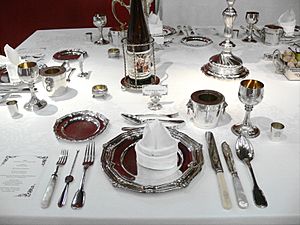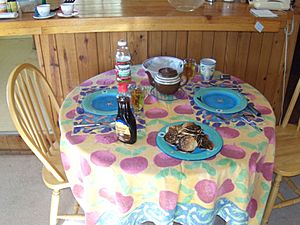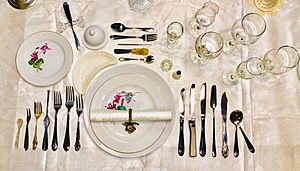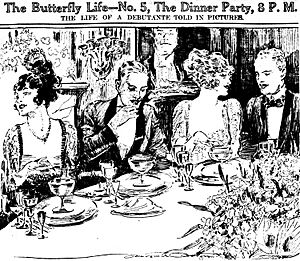Table setting facts for kids
Table setting is how you arrange plates, forks, knives, and spoons on a table before a meal. It's also called a "place setting" for one person. This practice involves putting out all the dishes and tools needed for eating. Different cultures and times have had their own special ways of setting tables.
Contents
Setting Your Place at the Table
When you set a table, you arrange the plates, forks, knives, and spoons for each person. Informal settings usually have fewer items, but they still follow a basic plan from more formal ones.
You arrange the eating tools (utensils) in the order you'll use them. In Western countries, forks, the main plate, a butter knife, and a napkin usually go on the left side of the dinner plate. Knives, spoons, glasses, cups, and saucers go on the right. (But in some places like Armenia or Turkey, forks might go on the right too!)
Serving dishes, like those for sauces, are placed on the table. For very fancy meals, they might be kept on a separate side table.
Casual Table Setting
For a casual meal, you use fewer eating tools. The serving dishes are often placed right on the table for everyone to reach. Sometimes, the cup and saucer are placed to the right of the spoon, about 30 centimeters (12 inches) from the table's edge.
In some less formal settings, the napkin might even be placed inside the wine glass. However, things like napkin rings are not very common in places like the United Kingdom, Spain, Mexico, or Italy.
Formal Table Setting
For a formal meal, all the eating tools are placed about 20 centimeters (8 inches) from the table's edge. They should all line up neatly. The tools you use first are placed on the outside. For example, a soup spoon or a salad fork would be on the very outside. Then, you'd find the dinner fork and dinner knife closer to the plate.
The blades of the knives always face towards the plate. Glasses are placed about 2.5 centimeters (1 inch) above the knives. They are also arranged in the order you'll use them: white wine glass, red wine glass, dessert wine glass, and then the water glass.
Setting for a Formal Dinner
At the fanciest dinners, the food is served directly from the kitchen. This means serving dishes are not put on the table. Each person has a main plate (called a service plate or dinner plate). They also have a bread roll (often on a small bread plate or in the napkin), a napkin, and their eating tools. Knives and spoons are on the right of the main plate, and forks are on the left.
Coffee is served in small cups called demitasses. A spoon is placed on the saucer to the right of the cup's handle. The only exception to these rules in Western countries was the old Spanish and Austrian royal courts. They placed all the eating tools to the right of the plate for each person.
For a slightly less formal dinner, where food isn't served from the kitchen, the dessert fork and spoon can be placed above the plate. The fork points to the right, and the spoon points to the left.
Formal Dining Examples
See also
 In Spanish: Servicio de mesa para niños
In Spanish: Servicio de mesa para niños


















